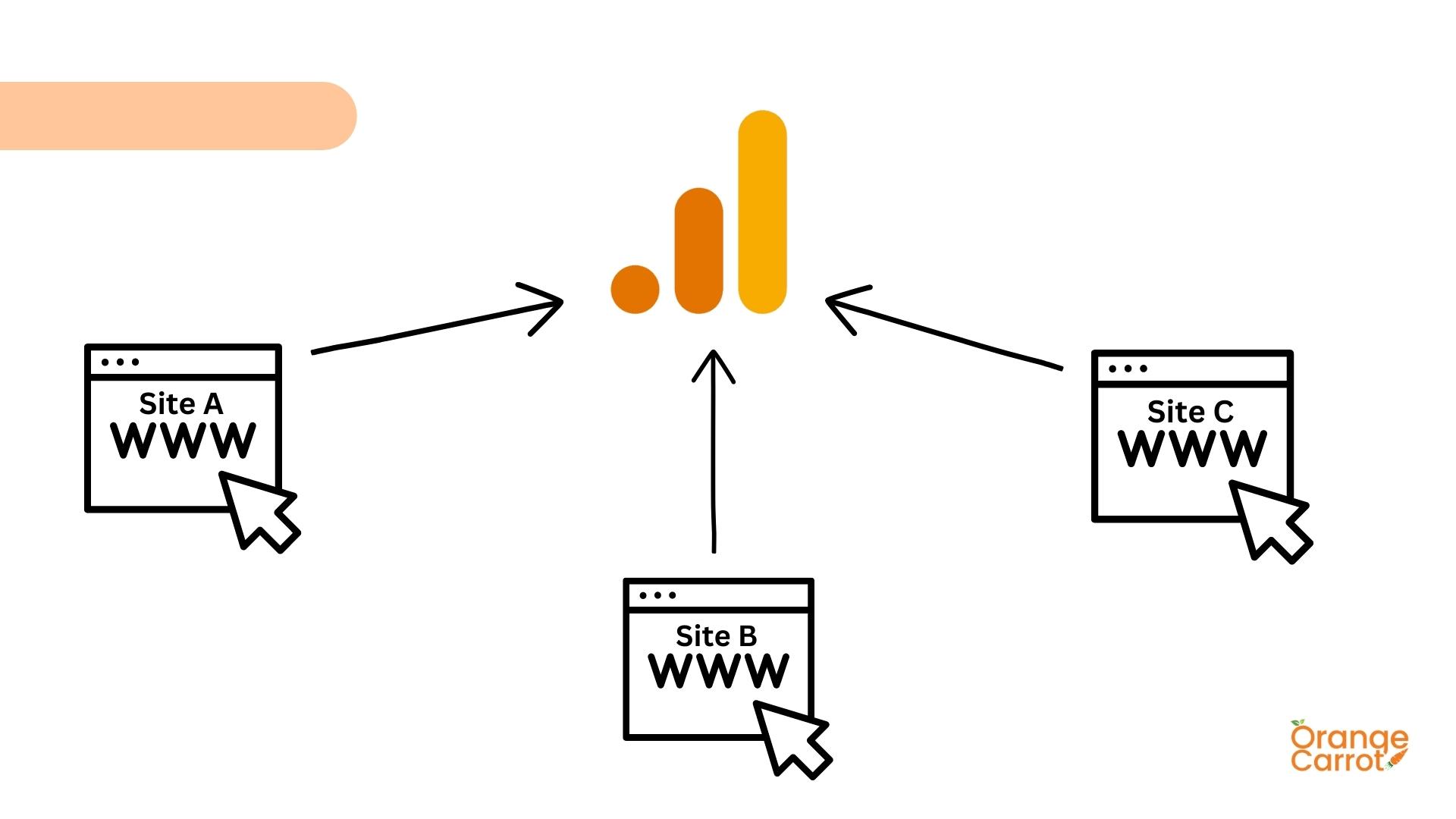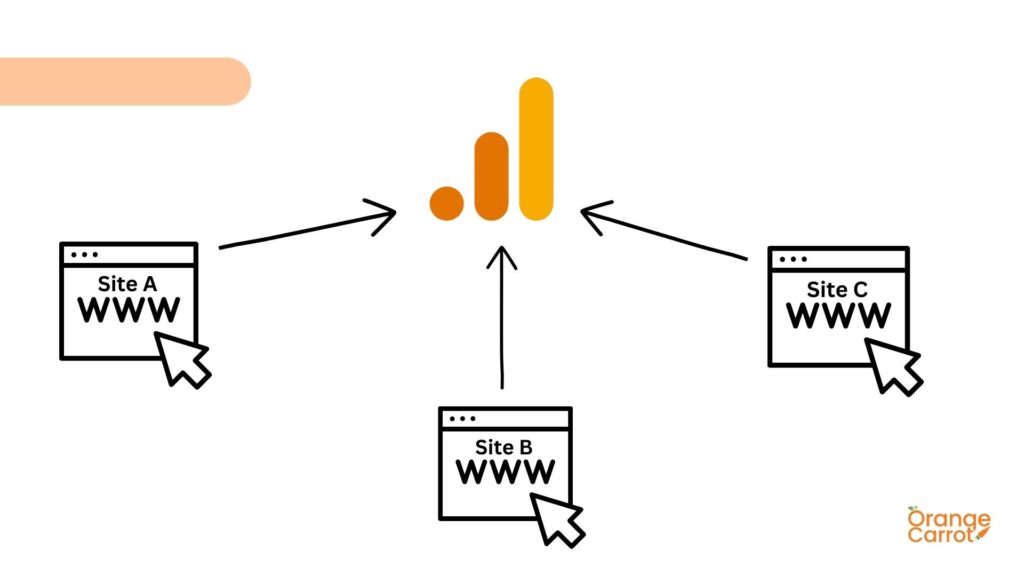1. Introduction to Cross-Domain Tracking
In today’s digital landscape, understanding how your users interact with your web properties is vital for success. One area of Google Analytics 4 (GA4) that has become particularly important for businesses operating across multiple domains or subdomains is Cross-Domain Tracking.
1.1. Definition and Importance of Cross-Domain Tracking
Cross-domain tracking refers to the process of tracking a single user’s journey across multiple websites or domains. In essence, it allows you to see a visitor’s interactions as a single session, even when they navigate across various domains under your ownership or partnership.
For example, if you have an e-commerce business where the shopping site is hosted on ‘www.example-shop.com’ and the checkout is handled on a separate domain like ‘checkout.example.com’, cross-domain tracking allows you to view the customer’s entire journey – from product selection to checkout – as one continuous session.
Cross-domain tracking’s importance lies in its capacity to provide a holistic view of user behavior. Without it, the user journey gets fragmented, creating a misunderstanding of how users are interacting with your websites. This could lead to misleading data about user behavior, and potentially, less effective decision-making for marketing strategy and website optimizations.
1.2. Differences between Cross-Domain Tracking in Universal Analytics (UA) and GA4
Understanding the differences between UA and GA4 in terms of cross-domain tracking is crucial. While both UA and GA4 offer cross-domain tracking, their approach and implementation differ significantly.
In UA, cross-domain tracking was handled by modifying the tracking code and employing the ‘linker’ parameter to pass the client ID from one domain to another. The Analytics.js library then added this parameter to URLs pointing to the destination domain.
On the other hand, GA4 handles cross-domain tracking in a more user-friendly way, with configurations managed directly within the interface rather than through tracking code modifications. It also extends its capabilities by offering enhanced measurement options and more flexible event tracking.
In the next sections, we will dive deeper into setting up cross-domain tracking in GA4, enabling you to take full advantage of this powerful feature to understand your users’ behavior across multiple domains.
2. Setting Up GA4
Google Analytics 4 is the latest iteration of Google’s powerful web analytics platform. Designed with an emphasis on tracking user journeys and events, it’s positioned to offer detailed, user-centric insights across platforms and devices.
2.1. Creating a new GA4 property
- Sign in to your Google Analytics account.
- Click 'Admin' in the lower-left corner of your screen.
- In the 'Account' column, ensure you've selected the account where you want to add the property.
- In the 'Property' column, click 'Create Property.'
- Enter a name for your property and choose the reporting time zone and currency.
- Click 'Next' to configure how you intend to use your property and provide the requested business information.
- Click 'Create' to finalize your new GA4 property.
Remember, GA4 property is different from the Universal Analytics (UA) property, and you can have both active at the same time to compare data.
2.2. Installing the GA4 tracking code
Once your GA4 property is set up, you need to install the GA4 tracking code (also known as a “tag”) on your website. Here are the steps to do so:
- In the GA4 property, click 'Data Streams' under 'Admin.'
- Select the appropriate data stream for your website (Web).
- After you've added your website, you'll see a 'Measurement ID.' This is your GA4 tracking code.
- Copy this Measurement ID and install it on your website. Depending on your website's structure, this can typically be done by adding the code to your website's header section. If you're using a CMS like WordPress, there are dedicated plugins that can simplify this task.
- Note: If you're using Google Tag Manager, you can use it to deploy the GA4 configuration tag instead of adding the code directly to your website.
By creating a GA4 property and installing the tracking code, you’ve successfully set up GA4 on your website. Now, you’re ready to delve deeper into GA4’s more complex features, such as cross-domain tracking.
3. Understanding the Concept of Domains in GA4
In GA4, understanding how domains are treated is crucial, especially when setting up cross-domain tracking. The concept differs slightly from Universal Analytics (UA) and is more attuned to the modern, user-centric and multi-platform approach of GA4.
3.1. Primary and Secondary Domains
In the context of cross-domain tracking, it’s important to differentiate between primary and secondary domains. The primary domain is where a user begins their journey, and secondary domains are any other domains the user visits during that journey.
For example, if a user starts on ‘www.example.com’ (primary domain) and then visits ‘shop.example.com’ or ‘blog.example.com’ (secondary domains), GA4 can track this as a single journey instead of treating it as separate sessions, given that the cross-domain tracking setup is correct.
3.2. How GA4 Treats Different Domains
Unlike UA, which relies on Referral Exclusion Lists to determine how to treat traffic between different domains, GA4 uses a ‘Domain Allow List’ and ‘Default Internal Traffic’ to specify which domains should be considered part of the same entity (and thus permit cross-domain tracking).
The Domain Allow List in GA4 is a list of domains that are recognized as being part of the same organization. It allows the GA4 configuration tag to accept linker parameters from the listed domains, enabling the linking of user journeys across these domains.
On the other hand, Default Internal Traffic is a setting used to mark where sessions start by default. It’s generally set to the domain where the majority of your traffic lands first.
Understanding these concepts is crucial for setting up and optimizing cross-domain tracking in GA4. In the next section, we will go through how to configure these settings to ensure accurate and comprehensive cross-domain measurement.
4. Configuring Cross-Domain Measurement in GA4
4.1. Setting up the Configuration Tag
To start tracking users across domains, you need to modify your existing GA4 configuration tag. Here’s how:
- Navigate to 'Admin' and click on 'Data Streams.'
- Click on the data stream that corresponds to the website you're tracking.
- Scroll down to 'Tagging Settings' and click 'Configure your tag for cross-domain measurement.'
- Under the 'Cross-Domain Measurement' section, you'll find options to configure the 'Domain Allow List' and 'Default Internal Traffic.'
4.2. Adding the Domain Allow List
The ‘Domain Allow List’ is where you specify all domains that are part of your organization and where you want to enable cross-domain tracking.
Click on ‘Add condition’ under the ‘Domain Allow List.’
Enter the domain (like ‘example.com’) that you want to include.
Repeat this process for all domains that should be part of cross-domain tracking.
4.3. Configuring the Linker Setup
The Linker parameter is what allows GA4 to recognize a user moving from one domain to another as the same user.
Under ‘Tagging Settings,’ click on the checkbox next to ‘Automatically decorate outbound links that point to domains on your allow list.’
In ‘Default Internal Traffic,’ select the domain where most of your traffic lands first. This ensures that GA4 correctly identifies the start of a user’s journey.
Remember, cross-domain measurement settings are applied at the property level. All data streams within the same property share these settings.
Once you’ve made these changes, GA4 will be able to track user interactions across multiple domains as part of a single session, providing a more holistic view of user behavior. Keep in mind that you may need to adjust your configurations as your business and website evolve to ensure accurate data collection.
5. Advanced Configuration of GA4 for Cross-Domain Tracking
Once the initial setup for cross-domain tracking in GA4 is complete, there are advanced configurations you can implement to collect even more detailed data about how users interact across your domains.
5.1. Setting up Event Parameters for Cross-Domain Tracking
GA4’s event-based model means you can track a variety of user interactions across your domains. By setting up specific event parameters, you can gain deeper insights into user behavior.
For example, if a user views a product on ‘www.example.com’ (your primary domain) and then completes a purchase on ‘checkout.example.com’ (your secondary domain), you can track this journey by setting up ‘view_item’ and ‘purchase’ events with appropriate parameters.
Remember, custom events and parameters need to be registered in GA4 to appear in your reports. Navigate to ‘All Events’ under the ‘Events’ section in ‘Admin’ to register your custom events and parameters.
5.2. Configuration for Shopping Carts and Payment Gateways
If your website uses a third-party shopping cart or payment gateway hosted on another domain, you need to take additional steps to ensure these sessions aren’t broken up.
Add the domain of your shopping cart or payment gateway to your ‘Domain Allow List.’
Make sure the third-party domain is capable of accepting and passing on linker parameters. This can often be the challenging part as you might need to work closely with your third-party provider to make sure this is configured correctly.
Remember, advanced configurations for cross-domain tracking should be implemented with a clear understanding of your website’s user flow and the interactions you want to track. Customizations should be made strategically and checked regularly to ensure you’re collecting the right data and making data-driven decisions
6. Implementing GA4 Cross-Domain Tracking with Google Tag Manager (GTM)
Google Tag Manager is a handy tool that simplifies the process of deploying tags and handling complex tracking setups like cross-domain tracking. Let’s walk through the process of implementing GA4 cross-domain tracking using GTM.
6.1. Configuring GTM for GA4
To start, you need to ensure that you have GA4 configured within GTM.
In your GTM workspace, click ‘New Tag.’
For ‘Tag Configuration,’ choose ‘GA4 Configuration.’
Enter your GA4 Measurement ID (you can find this in your GA4 ‘Data Stream’ settings).
Choose ‘All Pages’ for the triggering unless you want it to be event-specific.
6.2. Implementing Cross-Domain Tracking in GTM
Once the GA4 tag is set up, you can implement cross-domain tracking.
In the same GA4 Configuration Tag, locate ‘Fields to Set.’
Click ‘Add Row.’ In the ‘Field Name’ column, input ‘_ga_domains.’ In the ‘Value’ column, input the domains you want to track as an array (e.g., [‘example.com’, ‘shop.example.com’]).
Save the tag.
Remember, the ‘_ga_domains’ field is crucial for enabling GA4’s cross-domain tracking capability when using GTM.
It’s important to note that changes you make in GTM should mirror your GA4 settings. So, any domain you include in the ‘_ga_domains’ field should also be on your GA4 ‘Domain Allow List.’
After making these changes, make sure to test your setup and validate that the cross-domain tracking is working correctly.
Google Tag Manager, combined with GA4, is a potent tool for managing your website’s tracking setup. Understanding how to use these platforms effectively can provide you with rich, accurate data about your users’ behavior across multiple domains.
7. Validating and Testing the GA4 Cross-Domain Setup
Regardless of how confident you are in your setup, it’s crucial to validate and test your cross-domain tracking. This process helps ensure the accuracy of your data and troubleshoot any potential issues.
7.1. Real-Time Reporting
GA4’s real-time reporting feature is an excellent tool for initial validation.
In GA4, navigate to ‘Realtime’ from the left-hand menu.
Simultaneously, open a new private or incognito browser window and visit the first domain in your tracking setup.
Perform a specific action that you’re tracking, like clicking a link to your second domain.
In the GA4 Realtime report, verify that the action appears and that it’s attributed to the correct domain.
7.2. Debug View
DebugView is another powerful tool for verifying your setup.
Enable Debug mode in your GA4 setup. For website tracking, this often involves installing the Google Analytics Debugger extension for your web browser.
Perform actions across your domains as a user would.
Check DebugView in GA4 to see the flow of events in real-time. Verify that events from different domains appear as part of a single user journey, and the ‘page_location’ parameter reflects the correct URL for each event.
7.3. Checking User-ID Consistency
Finally, to verify that GA4 is tracking a user consistently across domains, you can check the User-ID.
Navigate to ‘All Events’ in GA4 and find an event that happened after the cross-domain transition.
Click into the event to view its parameters and check that the User-ID before and after the transition is the same.
Remember, testing and validation should be an ongoing process, not a one-time task. As you update your site, add new events, or make changes to your GA4 and GTM setup, you should revalidate to ensure your tracking remains accurate. Troubleshooting and monitoring are key to a successful cross-domain tracking strategy.
8. Troubleshooting Common Issues
Even with careful setup and validation, you may run into some common issues when implementing cross-domain tracking. Here are a few of the most common problems and their potential solutions:
8.1. Inconsistent User IDs Across Domains
If you’re seeing different User IDs for the same user across different domains, there might be an issue with the Domain Allow List or the linker setup in GTM.
Solution: Double-check your Domain Allow List and make sure all necessary domains are included. If you’re using GTM, ensure that the ‘_ga_domains’ field includes all the relevant domains and that the ‘Automatically decorate outbound links’ option is enabled.
8.2. Missing or Incorrect Data in Reports
If you’re not seeing the expected data in your GA4 reports, or the data appears incorrect, it may be due to a variety of issues, such as misconfigured tags or issues with event tracking.
Solution: Validate your tags in GTM and ensure that they’re triggering correctly. If you’re using custom events, double-check that they’re registered correctly in GA4. Using the DebugView and real-time reports can help identify if events are being sent and received correctly.
8.3. Cross-Domain Tracking Not Working with External Payment Gateways
If you’re using an external payment gateway, you might find that cross-domain tracking isn’t working when users are redirected to the gateway.
Solution: Ensure that the domain of the payment gateway is in your Domain Allow List. You also need to confirm that the payment gateway is configured to accept and pass on linker parameters. This might require coordination with the gateway’s support team.
8.4. High User Count with Low Engagement
If you notice a large number of users with only a single page view or event, it may indicate that sessions are being broken up between domains.
Solution: Confirm that your Domain Allow List is correctly configured and that the ‘Default Internal Traffic’ is set to the appropriate domain. Check the linker settings in GTM and ensure it’s set to decorate links to all domains in the allow list.
Remember, troubleshooting is often a process of trial and error. It requires patience, a systematic approach, and a strong understanding of your GA4 setup. Be methodical, and don’t hesitate to seek help from GA4’s comprehensive online resources or the analytics community when needed.
9. Case Studies of Effective Cross-Domain Tracking in GA4
Case Study 1: Multi-Brand Ecommerce Business
Consider a multi-brand ecommerce company with each brand hosted on a separate domain. Before implementing cross-domain tracking, the company struggled to understand the customer journey as customers often browsed products on multiple domains before making a purchase.
After setting up cross-domain tracking in GA4, they were able to analyze the user journey across different domains. The collected data revealed significant cross-domain activity which was previously unseen. The company could then leverage this data to optimize their marketing strategies, like adjusting cross-promotion efforts based on the popular navigation paths observed between brands.
Case Study 2: Blog and Ecommerce Site Integration
A company had a blog on ‘blog.example.com’ and an ecommerce store on ‘shop.example.com.’ They observed many users from the blog site but weren’t sure how many were navigating to the shop site.
After implementing cross-domain tracking in GA4, they discovered that a significant number of users were indeed navigating from the blog to the shop site after reading about their products. By effectively tracking user interactions across these domains, the company could directly measure the impact of their blog content on sales, leading to more informed content strategy decisions.
Case Study 3: Third-Party Shopping Cart Configuration
An online retailer used a third-party shopping cart, resulting in the checkout process being hosted on a different domain. They had difficulties tracking the user journey from product selection to purchase completion.
Once they added the third-party domain to their GA4 cross-domain configuration and ensured the linker parameters were correctly set up, they were able to track a user’s journey from the main site to the third-party checkout domain. This enabled them to accurately calculate conversion rates and understand at which point potential customers were abandoning their carts.
Each of these hypothetical scenarios demonstrates how GA4 cross-domain tracking can provide a more holistic view of the user journey, leading to valuable insights and more effective strategy adjustments.
10. Conclusion
Understanding Cross-Domain Tracking: Recognizing the significance of cross-domain tracking is crucial, especially for businesses operating across multiple domains or platforms. It’s the key to comprehending user journeys and making data-driven decisions.
As of now, Google Analytics 4 is Google’s most advanced and flexible analytics platform, and it’s continually being updated and refined.
Remember, success in digital analytics isn’t just about understanding the tools. It’s about using them to uncover actionable insights about your users, and GA4’s cross-domain tracking is a powerful tool in this endeavor.
"He who has traffic has the Gold".
Austin Lovvorn










